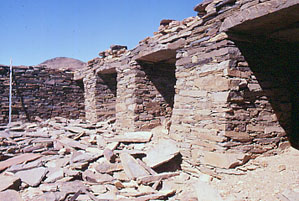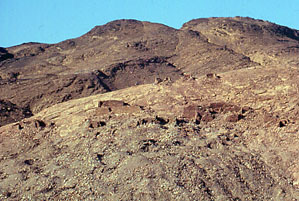|
The buildings in the settlement at Abu Rushaid are
well built and well preserved. Most have ancient mine shafts associated
with them. Many walls, with windows and niches, are still standing to their
original height:
|
|
The settlement at Abu Rushaid, built on the slope
of a hill, is part of a complex of settlements, mines and other structures
in the Mons Smaragdus area where once low grade emerald (beryl) was excavated:
|
|
|
|
|

|
|

|
|
|
|
|
|
|
|
|
Objective of visit:
|
|
To draw a measured plan of the site and study the surface
remains (including the ceramic finds). |
|
Date of visit:
|
|
- February 1998 |
|
Fellow visitors:
|
|
Eng. Brian Cannon. |
| Results: |
|
A survey was performed using the Global Positioning System
and a theodolite with steel tape measures. Off-site assistance was given
by pottery expert Dr. Roberta Tomber (Museum of London). No excavations
took place. Due to circumstances beyond our control the mapping of this
site remained unfinished. |
| Approximate position and date
of the site: |
|
The settlement at Abu Rushaid is in the Mons Smaragdus
area in the south-eastern part of the Egyptian Eastern desert, south-west
of Marsa Alam. Surface pottery dated to the early Roman period (ca.
30 BC - 200 AD). |
| Short description of the site: |
|
Abu Rushaid is one of the settlements in the Mons Smaragdus
area were low grade emerald (beryl) was excavated in ancient times. The
structures differ from those in contemporary gold mining settlements and
are much more elaborate. Most mine shafts have now collapsed but they seem
to have been very deep and rather narrow. |
| Additional remarks: |
|
Our work which, due to circumstances beyond our control
remained unfinished, was sponsored by the Berenike Project and private
donors. |
| HOME |
|
|
 |
|
|